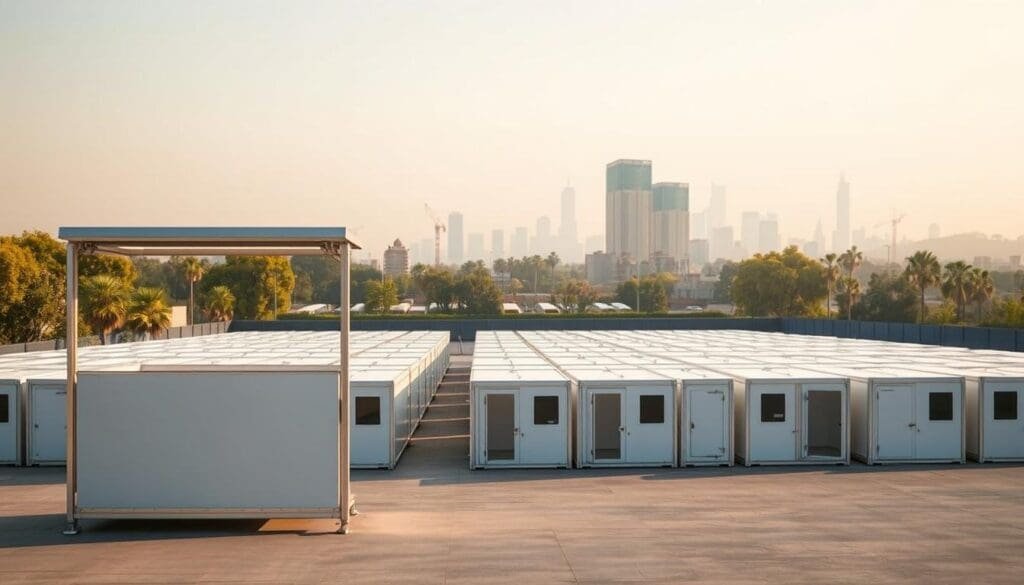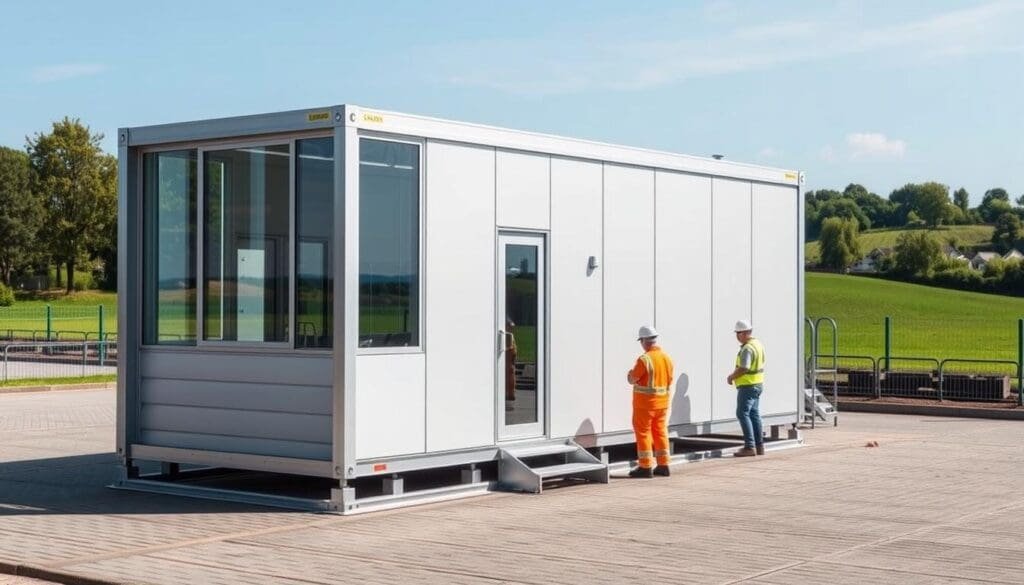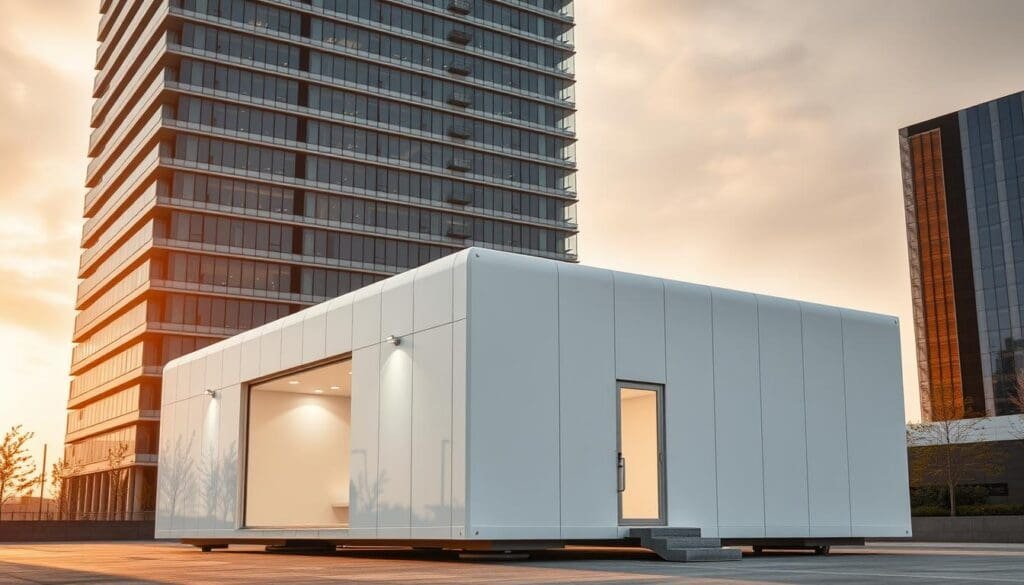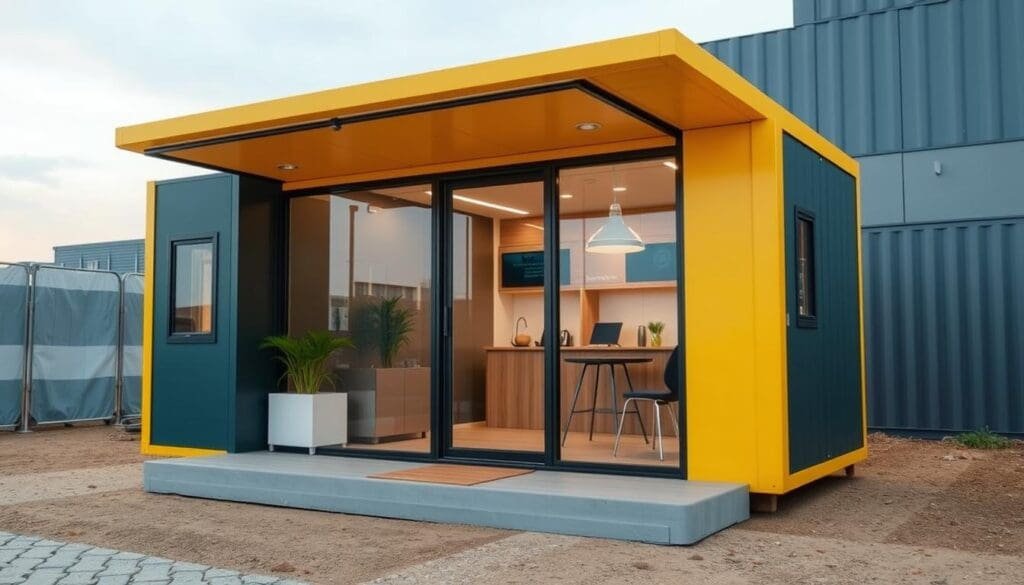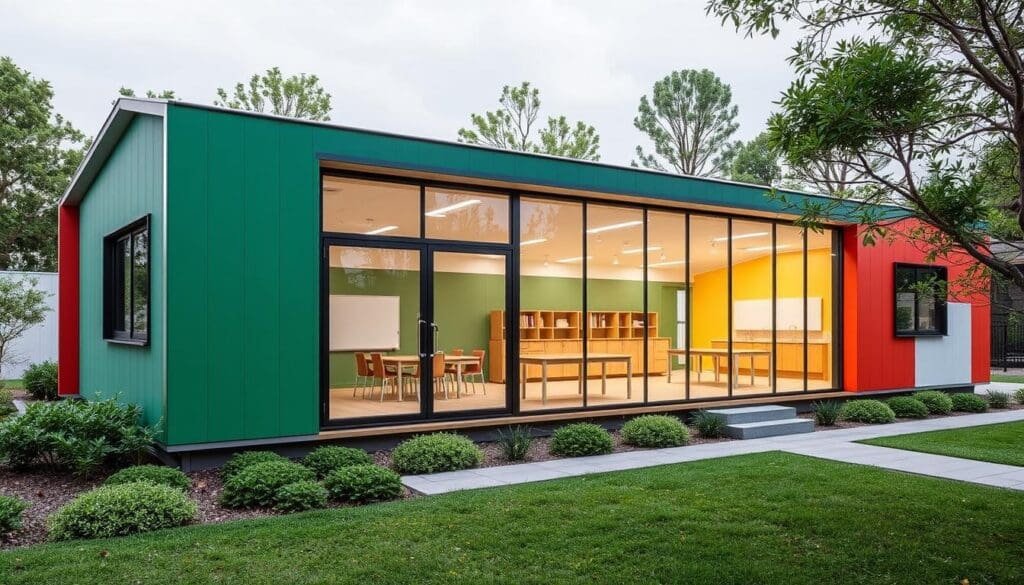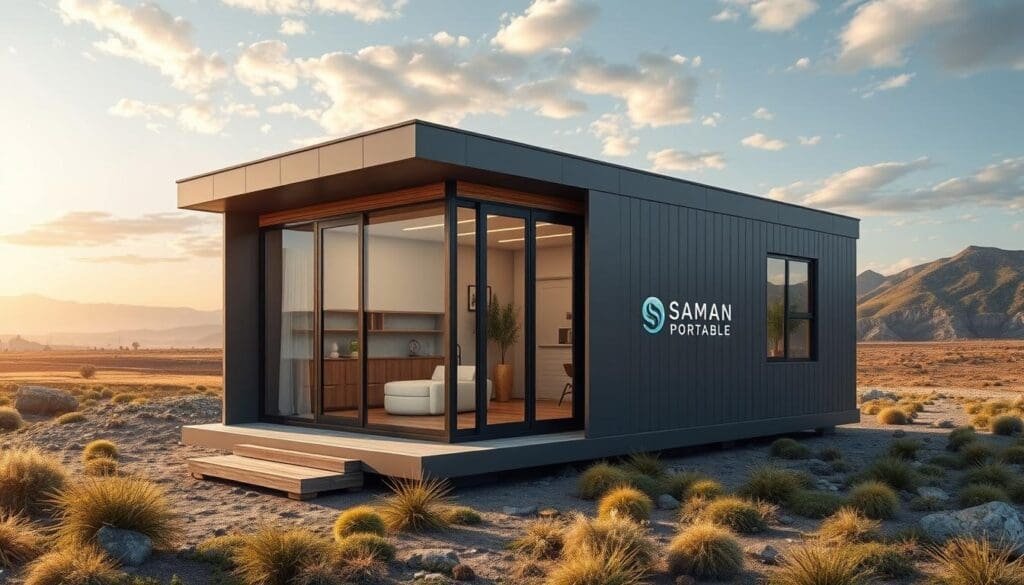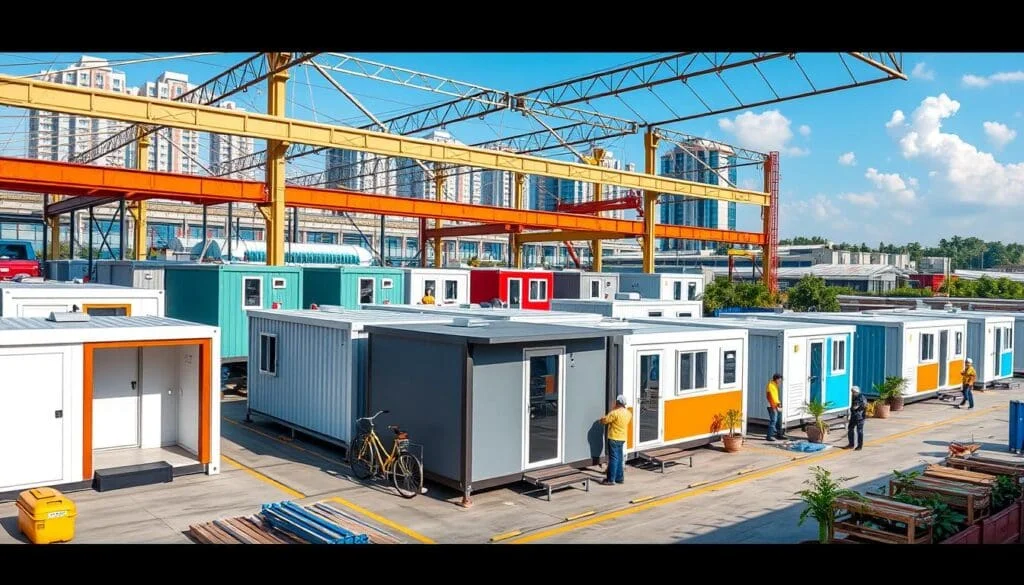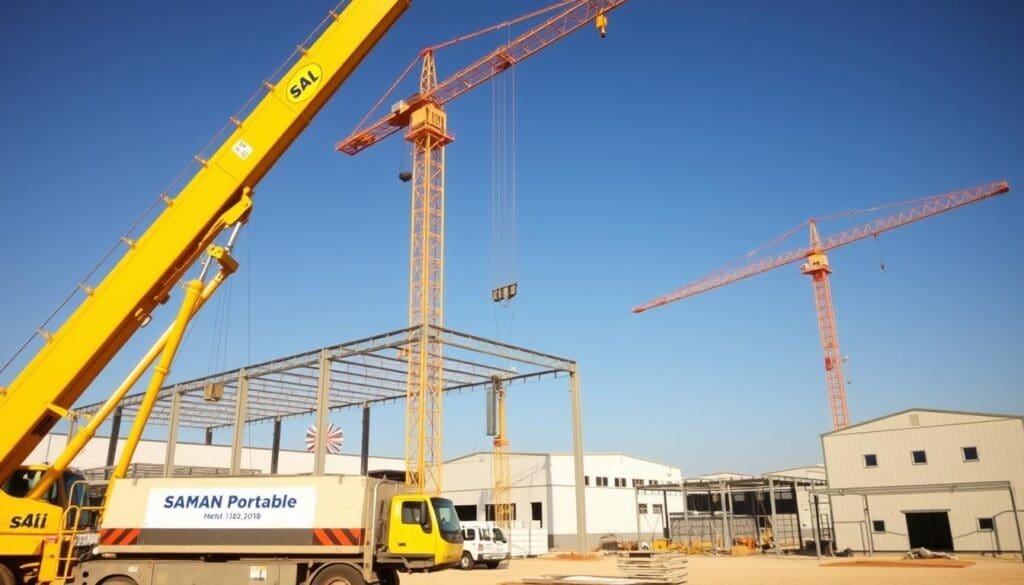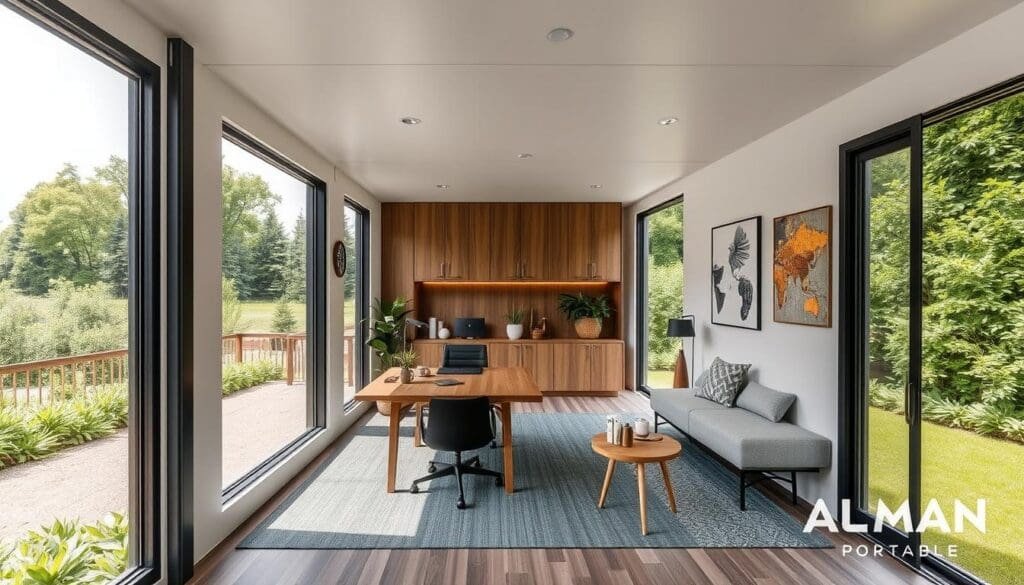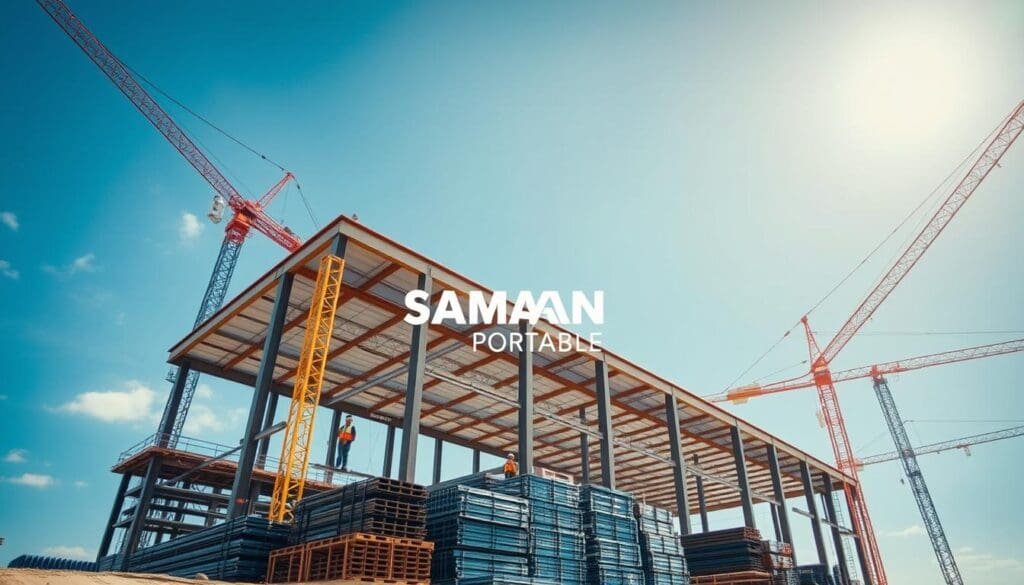Portacabin vs. Traditional Building: Which is Right for You?
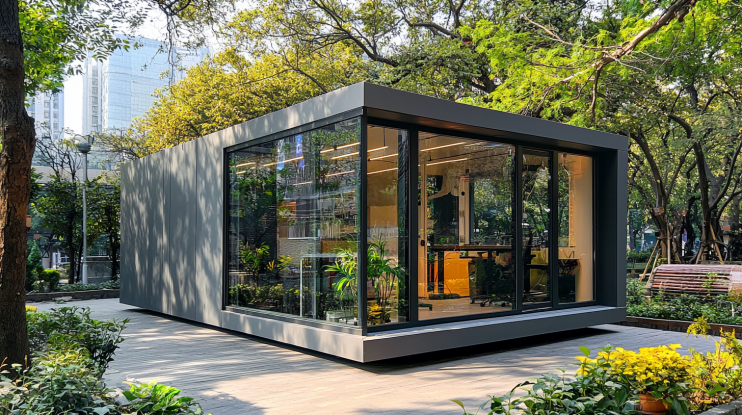
This blog delves into the critical comparison between Portacabins and traditional buildings, guiding you through the essential factors to consider when making a choice. It explores aspects such as cost, construction time, durability, design flexibility, and environmental impact, providing a comprehensive overview of the strengths and limitations of each option. Whether you’re looking for a quick, flexible solution with a Portacabin or a long-term, stable investment with a traditional building, this guide will help you make an informed decision tailored to your specific needs.
Introduction: Portacabin
When deciding between a Portacabin and a traditional building, it’s important to understand the unique benefits each option offers. Both choices have their own set of advantages, depending on your specific needs and circumstances. A Portacabin, often seen as a temporary solution, provides flexibility and speed, while traditional buildings are known for their durability and permanence. By comparing these two construction methods, you can make an informed decision that aligns with your project’s goals and budget.
Portacabins have become increasingly popular in recent years due to their adaptability and cost-effectiveness. They are prefabricated structures that can be easily transported and installed on-site, making them an attractive option for businesses and individuals needing quick and affordable space solutions. On the other hand, traditional buildings, constructed with materials like brick, concrete, and steel, offer a more permanent solution with a focus on longevity and stability. Understanding the differences in construction, costs, and uses will help you determine which option is better suited for your needs.
In this blog, we’ll explore the various aspects of both Portacabins and traditional buildings. From cost and construction time to design flexibility and environmental impact, we’ll cover everything you need to know to make the right choice. Whether you’re planning a temporary office, a long-term residence, or a commercial space, this comparison will provide valuable insights to guide your decision-making process.
Explore more about innovative, portable, and eco-friendly living spaces and how they compare to traditional buildings.
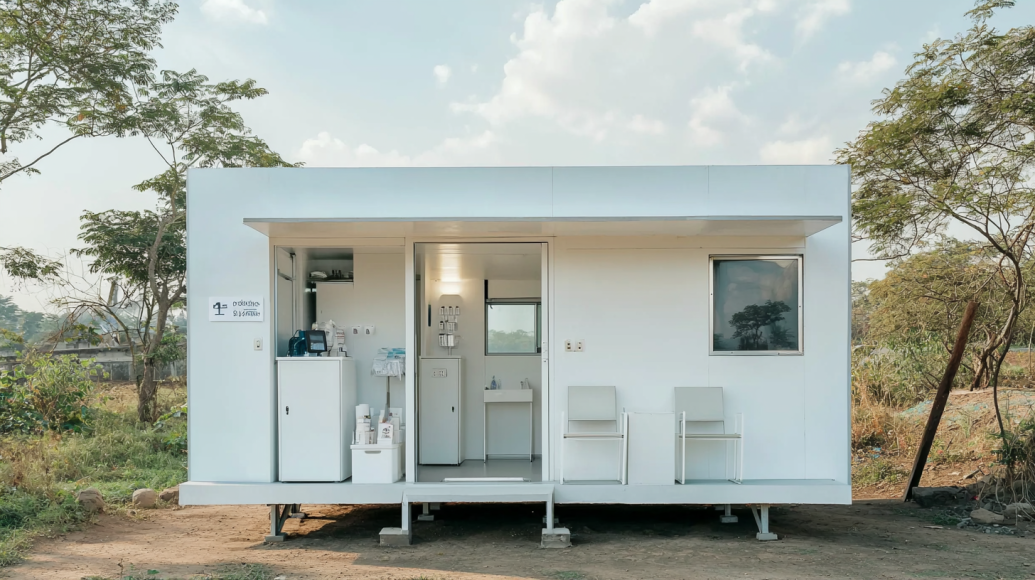
Essential 25-feet medical cabin in white, vital for rural health services.
Understanding Portacabin Construction
Portacabin construction is a modern approach that prioritizes efficiency and flexibility. These prefabricated structures are built off-site in controlled environments, allowing for precision and quality control that is hard to achieve in traditional construction. Once the components are ready, they are transported to the site and assembled quickly, reducing on-site labor and construction time. This method not only saves time but also minimizes the disruption often associated with traditional building projects.
The materials used in Portacabin construction are typically lightweight yet durable, such as steel frames and insulated panels. These materials are chosen for their ability to withstand various weather conditions while remaining easy to transport. Portacabins are designed to be modular, meaning they can be expanded or reconfigured as needed. This adaptability makes them a popular choice for businesses that require flexibility, such as temporary offices, classrooms, or event spaces.
Another key advantage of Portacabin construction is its environmental impact. Since the construction process occurs in a controlled factory setting, waste is minimized, and resources are used more efficiently. Additionally, the ability to relocate and reuse Portacabins reduces the need for new materials, making this construction method a more sustainable option compared to traditional buildings. By understanding these benefits, you can better appreciate why Portacabin construction is gaining popularity in various industries.
Learn about the latest trends in Modern Porta Cabin construction and how they enhance functionality.
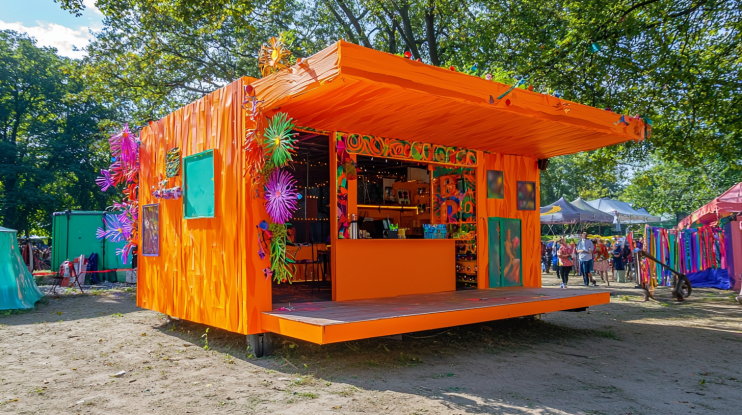
Energetic 40-feet event cabin in orange, perfect for lively festivals.
Understanding Traditional Building Construction
Traditional building construction has been the standard for centuries, offering a time-tested approach to creating permanent structures. These buildings are typically made from materials like brick, concrete, and wood, chosen for their durability and ability to withstand the elements. The construction process for traditional buildings involves several stages, including site preparation, foundation laying, and the erection of the building’s framework, all of which can take months or even years to complete.
One of the main advantages of traditional building construction is its longevity. These structures are built to last, often standing for decades or even centuries with proper maintenance. The solid materials used in traditional construction provide excellent thermal mass, helping to regulate indoor temperatures and reduce energy costs over time. This makes traditional buildings a preferred choice for long-term investments, such as residential homes, office buildings, and commercial spaces.
However, traditional building construction also comes with challenges. The process is often time-consuming and can be affected by weather conditions, labor availability, and material costs. Additionally, once a traditional building is constructed, it is difficult to modify or relocate, making it less flexible than Portacabins. Despite these drawbacks, traditional buildings remain a popular choice for those seeking a permanent, durable solution that reflects classic architectural styles and long-term value.
For a broader perspective on building options, explore our complete guide to Porta Cabins.
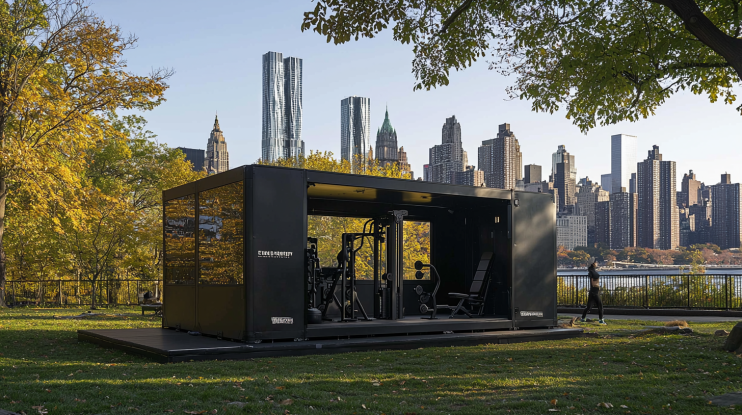
Stylish 32-feet portable gym cabin in black, ideal for outdoor fitness.
Cost Comparison
When comparing the costs of Portacabins and traditional buildings, it’s clear that both options have distinct financial implications. Portacabins are generally more affordable upfront, as they require fewer materials, less labor, and shorter construction times. The prefabricated nature of Portacabins allows for mass production, which drives down costs. For businesses or individuals on a tight budget, this makes Portacabins an attractive option, especially for temporary or semi-permanent needs.
Traditional buildings, however, tend to be more expensive due to the extensive materials and labor involved in their construction. Brick, concrete, and steel are not only costly but also require skilled labor, which adds to the overall expense. Additionally, traditional buildings often come with higher property taxes and insurance premiums, which can increase the long-term costs. These buildings are typically seen as a long-term investment, justifying the higher initial costs with durability and longevity.
Despite the higher costs, traditional buildings offer value in terms of resale and long-term use. They are generally perceived as more valuable assets, often appreciating over time. On the other hand, Portacabins may depreciate faster, especially if used as temporary structures. However, for those looking for a cost-effective, flexible solution with lower initial investment, Portacabins provide a viable alternative to traditional construction.
For a detailed breakdown, check out our comprehensive Porta Cabin Price Guide for 2024.
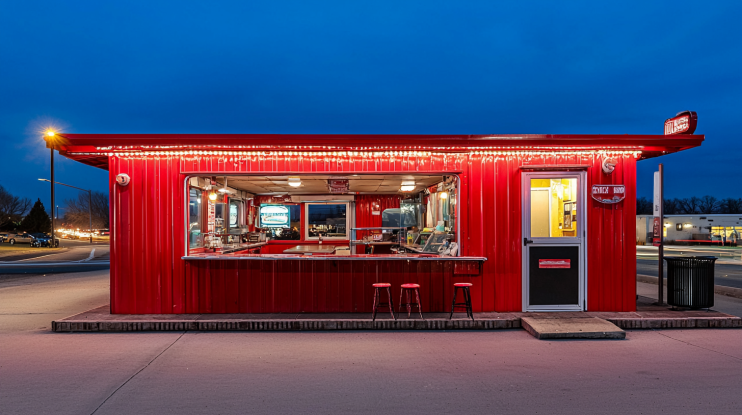
Nostalgic 24-feet diner cabin in red, a perfect stop on the highway.
Time to Completion
One of the most significant differences between Portacabins and traditional buildings is the time required for construction. Portacabins are known for their rapid assembly. Since the majority of the construction is done off-site in a controlled factory environment, the on-site installation process is streamlined and efficient. In many cases, a Portacabin can be fully assembled and ready for use in a matter of days or weeks, making it an ideal choice for projects with tight deadlines.
Traditional buildings, on the other hand, require a much longer construction timeline. From site preparation and foundation laying to the actual building process, it can take several months or even years to complete a traditional structure. This extended timeline can lead to delays, especially if unforeseen circumstances such as bad weather or labor shortages arise. For projects that require immediate occupancy or quick turnaround, the lengthy construction process of traditional buildings can be a significant disadvantage.
The faster construction time of Portacabins also translates into cost savings. With less time spent on-site, labor costs are reduced, and the project can be completed within budget. Additionally, the quicker completion allows for earlier occupancy, which can be crucial for businesses looking to start operations as soon as possible. This time efficiency makes Portacabins a preferred option for those who prioritize speed without compromising quality.
See how prefab designs enable quick and efficient construction, reducing overall project timelines.
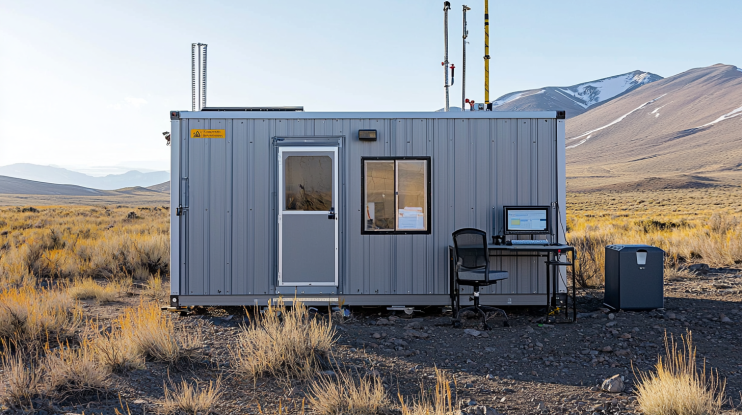
Advanced 28-feet research lab cabin in light gray, perfect for field studies.
Design Flexibility and Customization
Portacabins offer a high level of design flexibility and customization that is hard to match with traditional buildings. These modular structures can be easily adapted to meet specific needs, whether it’s for an office, classroom, or temporary housing. The modular nature of Portacabins allows for the addition or removal of sections, making it simple to expand or reconfigure the space as requirements change. This flexibility is particularly valuable for businesses that need to scale up or down quickly.
Traditional buildings, while offering a broader range of architectural styles and materials, are generally less flexible in terms of customization. Once a traditional building is constructed, making significant changes to its design can be costly and time-consuming. While traditional buildings allow for more creative freedom in terms of aesthetics and structural elements, these modifications often require extensive planning and approval processes. This rigidity can be a drawback for projects that require adaptable spaces or quick alterations.
In addition to flexibility, Portacabins can be customized with various finishes, fixtures, and features to match the specific aesthetic or functional requirements of the user. From energy-efficient windows to advanced HVAC systems, these structures can be tailored to meet a wide range of needs. Traditional buildings, though more permanent, do offer a higher degree of design freedom in terms of materials and finishes. However, this freedom comes at a higher cost and with less flexibility for future changes.
Discover how Luxury Porta Cabins offer bespoke design options for various needs.
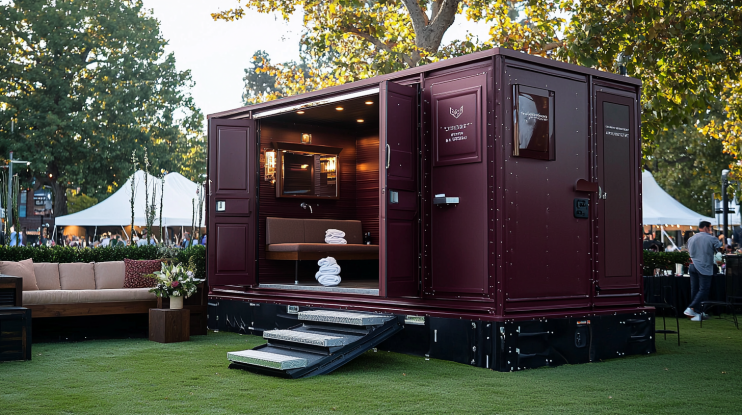
Luxurious 35-feet portable restroom cabin in maroon, ideal for upscale events.
Durability and Longevity
When comparing the durability and longevity of Portacabins and traditional buildings, each has its strengths depending on the intended use. Portacabins, built with sturdy materials like steel frames and insulated panels, are designed to withstand various weather conditions and frequent relocation. Although they are generally considered temporary or semi-permanent structures, modern Portacabins can last for several decades if properly maintained. This makes them suitable for long-term use in industries like education, healthcare, and emergency housing.
Traditional buildings, constructed with materials such as brick, concrete, and wood, are known for their exceptional durability. These structures can last for centuries if maintained appropriately, making them a preferred choice for permanent residences, commercial properties, and institutions. The materials used in traditional construction are typically more resilient to wear and tear, and the buildings can endure harsh environmental conditions, including storms, earthquakes, and extreme temperatures. The longevity of traditional buildings is a significant factor for those looking for a long-term investment.
However, the long lifespan of traditional buildings comes with higher maintenance requirements and costs. While Portacabins may not last as long as traditional buildings, their lower maintenance needs and the ability to replace or upgrade components as needed offer a practical alternative. The choice between Portacabins and traditional buildings ultimately depends on the project’s duration and the level of permanence required.
Explore the transformative world of modular Porta Cabins and their impact on modern construction.
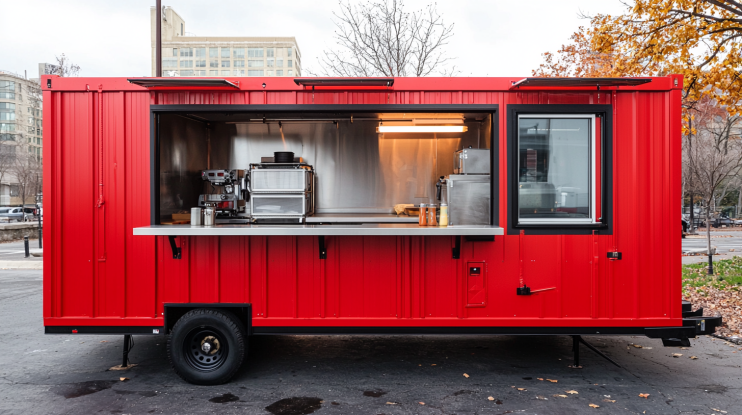
Dynamic 24-feet mobile kitchen cabin in red, a top choice for food truck parks.
Mobility and Relocation
Portacabins are designed with mobility in mind, making them a versatile solution for businesses and individuals who need temporary or mobile structures. One of the key advantages of Portacabins is their ability to be easily transported from one location to another. This mobility is particularly beneficial for industries like construction, where temporary offices, housing, or storage facilities need to be relocated frequently. The ease of relocation also makes Portacabins an excellent choice for disaster relief operations, where quick deployment is essential.
Traditional buildings, on the other hand, are fixed structures that cannot be moved once constructed. This lack of mobility makes them suitable for permanent installations where relocation is not anticipated. However, this also means that traditional buildings are less adaptable to changing needs or circumstances. If a business or project requires relocation, the cost and complexity of moving or replicating a traditional building can be prohibitive, leading to potential financial and operational challenges.
The ability to relocate Portacabins with minimal disruption and cost makes them a preferred option for dynamic environments where flexibility is crucial. Whether for temporary events, construction sites, or emergency situations, the portability of Portacabins offers a level of convenience and adaptability that traditional buildings cannot match. This flexibility allows for efficient use of resources and space, making Portacabins an ideal choice for those who value mobility in their infrastructure.
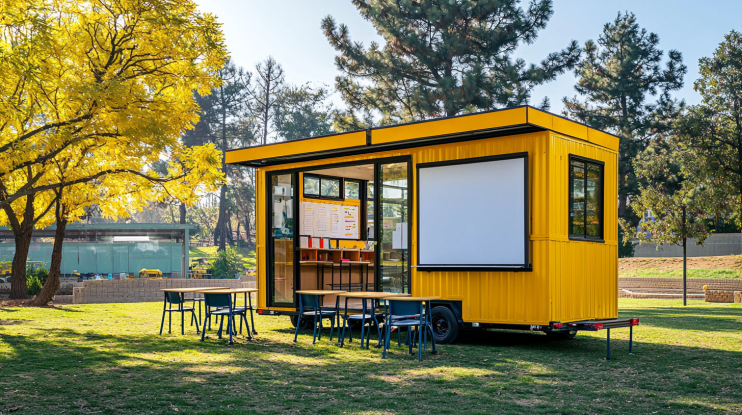
Bright 20-feet mobile classroom cabin in yellow, enhancing rural education.”
Sustainability and Environmental Impact
Sustainability is becoming an increasingly important factor in construction, and both Portacabins and traditional buildings offer different environmental benefits. Portacabins, with their modular and prefabricated nature, are often more sustainable than traditional buildings. The off-site construction process for Portacabins reduces waste and minimizes the environmental impact on the building site. Additionally, the materials used in Portacabins are often recyclable, and the structures themselves can be reused or repurposed, further reducing the need for new resources.
Traditional buildings, while durable and long-lasting, typically have a larger environmental footprint due to the extensive use of raw materials like concrete, steel, and wood. The construction process for traditional buildings often involves significant site disruption, higher energy consumption, and more waste. However, traditional buildings can be made more sustainable through the use of green building practices, such as incorporating energy-efficient systems, using sustainable materials, and implementing waste reduction strategies during construction.
When considering sustainability, Portacabins offer a more environmentally friendly option for projects that require quick, adaptable, and resource-efficient solutions. Their ability to be relocated and repurposed also reduces the need for new construction, which contributes to lower overall environmental impact. For those looking to minimize their ecological footprint, Portacabins provide a viable alternative to traditional construction methods.
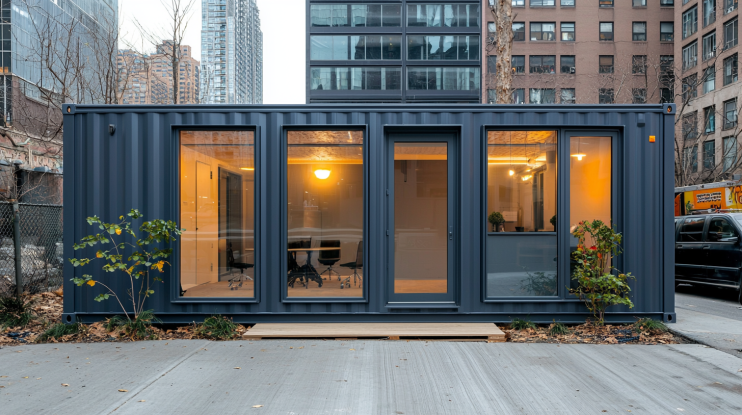
Modern 20-feet container office in metallic gray, ideal for urban business settings.
Maintenance and Repairs
Maintenance and repairs are crucial considerations when choosing between a Portacabin and a traditional building. Portacabins are designed to be low-maintenance, which is one of their significant advantages. The materials used, such as steel frames and insulated panels, are resistant to corrosion, weathering, and pests. This makes Portacabins easier and less costly to maintain over time. When repairs are needed, they are typically straightforward and quick to perform, often requiring less specialized labor than traditional buildings.
Traditional buildings, however, often require more extensive maintenance due to their use of materials like brick, wood, and concrete. These materials, while durable, are more susceptible to issues such as cracking, water damage, and pest infestations. Regular maintenance tasks for traditional buildings might include painting, sealing, and replacing worn-out components like roofing or plumbing. Additionally, repairs can be more complex and expensive, particularly if structural issues arise, necessitating the involvement of skilled tradespeople and sometimes even significant downtime for the building.
Despite the higher maintenance requirements, traditional buildings offer longevity and a sense of permanence that Portacabins may lack. However, for those seeking a solution with lower ongoing maintenance costs and quicker repairs, Portacabins present a compelling option. The choice between the two will depend on the specific needs of the project and the resources available for long-term upkeep.
Learn about the best uses for Porta Cabins and maintenance tips in our Top 7 Uses for Porta Cabins.
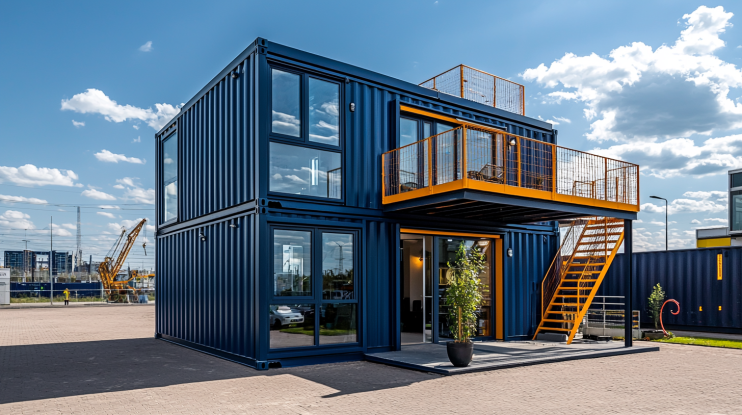
Sophisticated 40-feet double-storey container office in navy blue, perfect for industrial sites.
Energy Efficiency
Energy efficiency is a key factor in the decision between Portacabins and traditional buildings, especially as energy costs continue to rise and environmental concerns grow. Portacabins, particularly modern ones, are often built with energy efficiency in mind. They can be equipped with advanced insulation, energy-efficient windows, and HVAC systems that minimize energy use. The compact design of Portacabins also helps reduce the amount of energy required to heat or cool the space, making them an environmentally friendly option.
Traditional buildings, while offering more space and design flexibility, can be less energy-efficient depending on the materials used and the design. Older buildings, in particular, may lack the modern insulation and energy-efficient systems found in newer constructions. However, traditional buildings can be retrofitted with energy-efficient technologies, such as solar panels, double-glazed windows, and high-efficiency heating and cooling systems. These upgrades can significantly improve the energy performance of a traditional building, though they often come at a higher initial cost.
For those prioritizing energy efficiency, Portacabins may offer a more straightforward solution with their built-in energy-saving features. Traditional buildings, while potentially more energy-intensive, can still achieve high levels of efficiency with the right modifications. The decision will depend on whether the priority is immediate energy savings or the potential for long-term upgrades in a traditional setting.
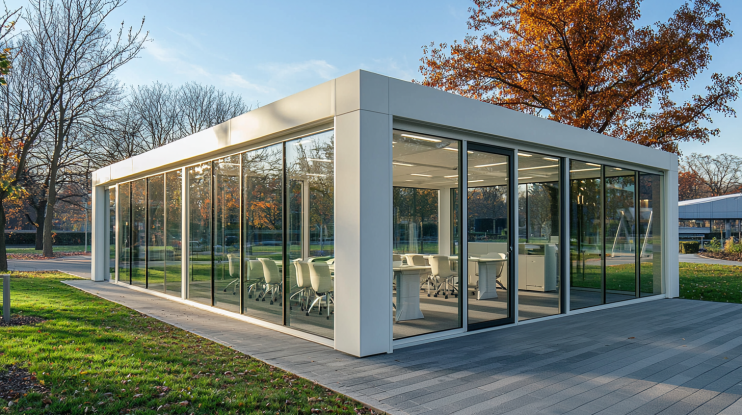
Elegant L-shaped 30-feet portable cabin in white, designed as a modern meeting room.
Aesthetics and Curb Appeal
Aesthetics and curb appeal play an essential role in how a building is perceived, whether it’s a Portacabin or a traditional structure. Portacabins, while highly functional and customizable, often have a more utilitarian appearance. However, modern designs have improved significantly, offering sleek finishes and creative architectural elements that enhance their visual appeal. With the right customization, including exterior cladding, landscaping, and design features, Portacabins can achieve a look that suits various environments, from contemporary offices to cozy living spaces.
Traditional buildings, on the other hand, offer a broader range of aesthetic possibilities. The use of materials like brick, stone, and wood allows for more diverse architectural styles, from classic to modern. Traditional buildings often exude a sense of permanence and prestige, which can be particularly important for residential homes, commercial properties, or institutions. The ability to incorporate intricate details, such as cornices, columns, and other decorative elements, adds to the charm and appeal of traditional buildings.
Despite the differences, both Portacabins and traditional buildings can be designed to meet specific aesthetic preferences. The choice between the two will largely depend on the intended use and the desired visual impact. For projects where curb appeal is crucial, traditional buildings may offer more options, while Portacabins provide a practical and increasingly attractive alternative for those seeking functionality with modern design enhancements.
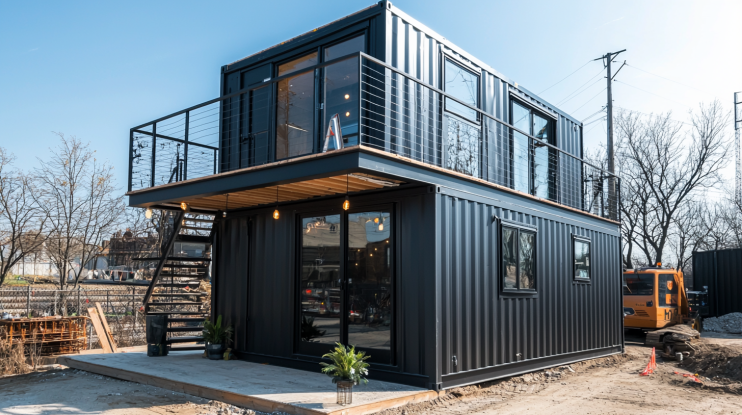
Industrial 50-feet double-storey container office in matte black, ideal for construction sites.
Building Regulations and Permits
When it comes to building regulations and permits, the requirements for Portacabins and traditional buildings can differ significantly. Portacabins, often considered temporary or semi-permanent structures, may have more lenient permitting processes compared to traditional buildings. However, this can vary depending on local regulations and the intended use of the Portacabin. For example, if a Portacabin is to be used as a permanent office or living space, it may be subject to stricter building codes and zoning laws, similar to those governing traditional buildings.
Traditional buildings are typically subject to comprehensive building codes, zoning laws, and permitting processes. These regulations ensure that the construction meets safety standards, environmental guidelines, and aesthetic requirements set by local authorities. Obtaining permits for traditional buildings often involves submitting detailed architectural plans, undergoing inspections at various stages of construction, and complying with specific codes related to fire safety, accessibility, and structural integrity. This process can be time-consuming and costly but is essential for ensuring the long-term safety and compliance of the structure.
For both Portacabins and traditional buildings, it is crucial to consult with local authorities and understand the specific regulations that apply to your project. Failure to obtain the necessary permits or comply with building codes can result in fines, delays, or even the requirement to modify or remove the structure. While Portacabins might offer a quicker path to approval in some cases, both types of construction require careful planning and adherence to legal requirements to avoid complications.
For insights on compliance and standards, visit our Porta Cabins Overview page.
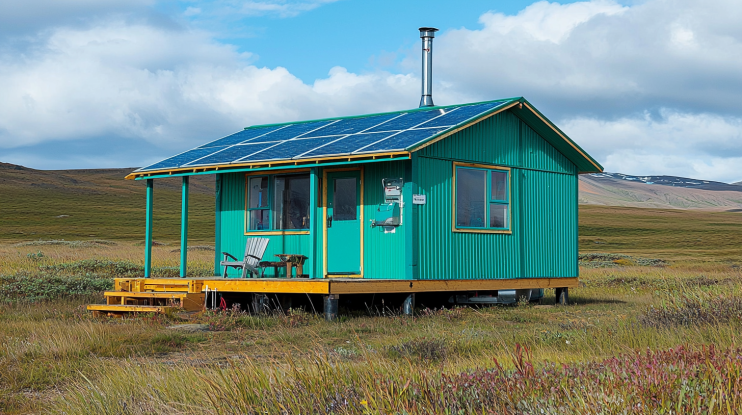
Eco-friendly 15-feet portable cabin in teal, perfect for remote research stations.
Insurance and Financing Options
Insurance and financing options for Portacabins and traditional buildings differ due to the nature and intended use of each structure. Portacabins, often seen as temporary or semi-permanent, might be insured under different terms compared to traditional buildings. Insurance for Portacabins typically covers risks like transportation, installation, and temporary use. However, the premiums may be lower due to the structure’s perceived lower value and shorter lifespan. Additionally, some insurers might offer specialized policies tailored to the specific needs of Portacabin users, including coverage for modular construction.
Traditional buildings, being permanent and often higher in value, usually require more comprehensive insurance coverage. This includes protection against risks such as fire, natural disasters, theft, and liability. The insurance premiums for traditional buildings are generally higher due to the broader range of risks and the longer-term nature of the investment. Financing options for traditional buildings are also more extensive, with the availability of mortgages, construction loans, and other long-term financing products. These options reflect the higher costs and longer investment horizon associated with traditional construction.
When it comes to financing, Portacabins may offer more flexibility. Since they are often less expensive and quicker to construct, financing might involve shorter loan terms or alternative financing options like leasing. Some companies also provide financing packages specifically designed for modular construction, allowing for easier payments over time. The choice between Portacabins and traditional buildings will depend on your financial situation, the intended use of the structure, and the availability of insurance and financing options that align with your needs.
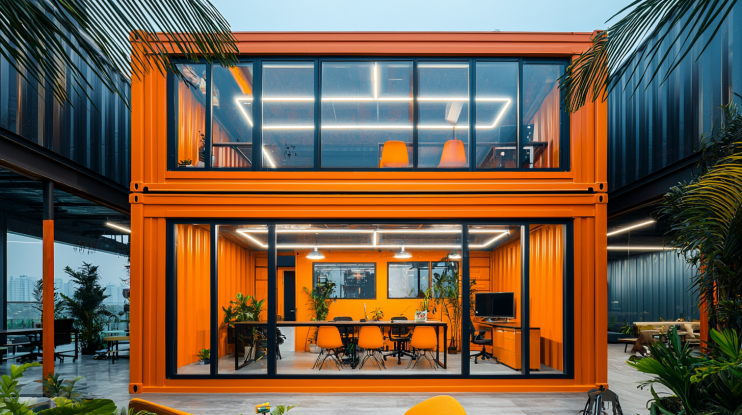
Vibrant 60-feet double-storey container office in orange, perfect for tech startups.
Scalability and Expansion
Scalability and expansion are critical factors when deciding between a Portacabin and a traditional building. Portacabins are inherently designed for scalability. Their modular construction allows for easy expansion by simply adding more units to the existing structure. This flexibility is particularly beneficial for businesses that expect to grow or need to adjust their space requirements quickly. Whether it’s adding more office space, classrooms, or storage, Portacabins offer a straightforward and cost-effective solution for expansion without significant disruption.
Traditional buildings, while offering more permanent and durable structures, present challenges when it comes to scalability. Expanding a traditional building often requires significant construction work, which can be time-consuming, costly, and disruptive to ongoing operations. This might involve adding new floors, extending the footprint of the building, or even retrofitting the structure to accommodate new uses. The complexity of such expansions often necessitates detailed planning, additional permits, and a substantial financial investment.
For businesses or projects that anticipate future growth or changes in space needs, Portacabins offer a level of flexibility that traditional buildings cannot match. The ability to scale up or down quickly and affordably makes Portacabins an attractive option for dynamic environments. In contrast, traditional buildings are better suited for long-term stability and permanence, making them ideal for projects where future expansion is not anticipated or where the investment in a more complex expansion process is justified.
For more information, refer to our buying guide on purchasing Porta Cabins online.
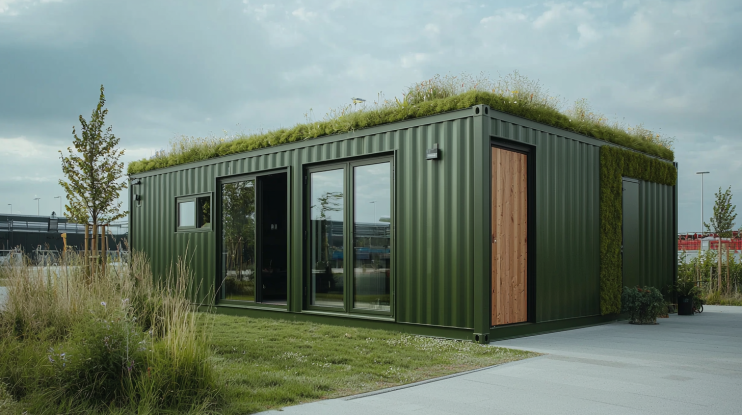
Sustainable L-shaped 25-feet container office in olive green, ideal for eco-business parks.
Weather Resistance
Weather resistance is a crucial factor to consider when choosing between a Portacabin and a traditional building. Portacabins, while designed to be sturdy and durable, are often constructed with lightweight materials such as steel frames and insulated panels. These materials are generally resistant to various weather conditions, including heavy rain, wind, and moderate snowfall. However, extreme weather events like hurricanes or severe storms might pose challenges to Portacabins, depending on their design and the quality of materials used. Reinforcement options are available to enhance their resilience, but they may not match the robustness of traditional buildings.
Traditional buildings, constructed with materials like brick, concrete, and wood, are inherently more resistant to extreme weather conditions. These materials provide excellent protection against high winds, heavy snow, and other environmental factors. Traditional buildings are often designed with local climate considerations in mind, ensuring that they can withstand the specific weather challenges of the region. This makes them a preferred choice in areas prone to extreme weather events, where durability and stability are paramount.
Despite the inherent differences, advancements in Portacabin construction have led to improved weather resistance. Features such as reinforced panels, better insulation, and weatherproof seals can significantly enhance the performance of Portacabins in challenging climates. However, if long-term weather resistance is a top priority, traditional buildings might offer a higher level of security and peace of mind.
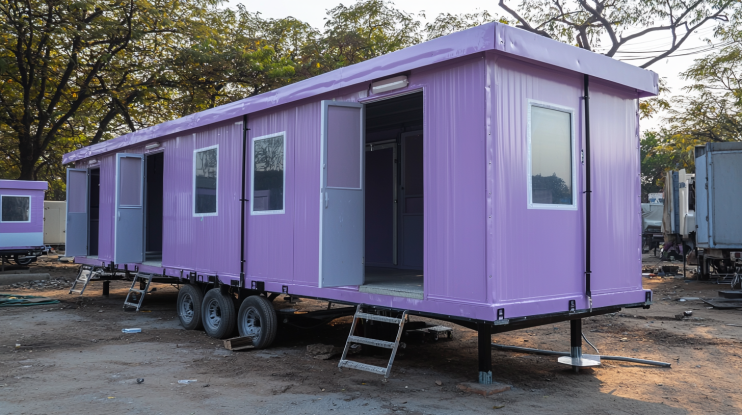
Efficient 35-feet healthcare cabin in lavender, perfect for rural health camps.
Soundproofing and Privacy
Soundproofing and privacy are important considerations in both residential and commercial buildings. Portacabins, due to their modular construction and the materials used, may offer varying levels of sound insulation. Modern Portacabins are often equipped with soundproof panels and insulation to enhance privacy and reduce noise transmission. This makes them suitable for environments where noise control is essential, such as offices, classrooms, or temporary accommodations. However, the level of soundproofing may not be as comprehensive as that found in traditional buildings.
Traditional buildings, with their solid walls made from brick, concrete, or wood, typically provide better soundproofing and privacy. The thicker walls and more substantial materials used in traditional construction create a natural barrier against noise, ensuring a quieter and more private environment. This is particularly important in residential areas or commercial spaces where confidentiality and peace are crucial. The architectural design of traditional buildings also allows for the integration of advanced soundproofing technologies, further enhancing their effectiveness.
While Portacabins can be customized to improve soundproofing, they may still fall short compared to traditional buildings in this regard. For projects where sound control and privacy are top priorities, traditional buildings may offer superior performance. However, for temporary or flexible spaces, Portacabins with enhanced soundproofing features can still provide a comfortable and private environment.
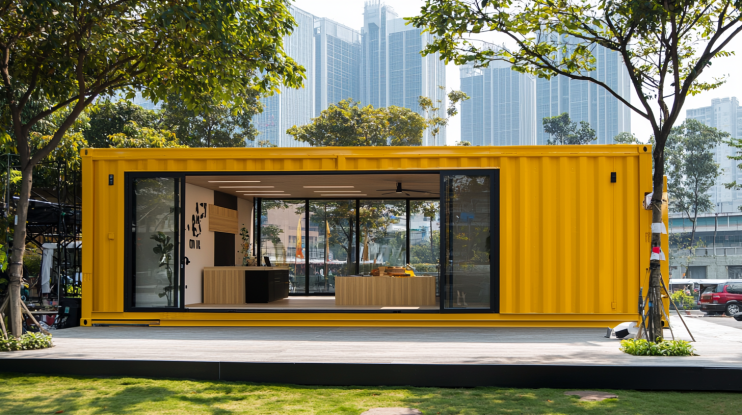
Bright 20-feet container office in mustard yellow, ideal for event venues.
Use Cases: Ideal Scenarios for Each
The ideal use cases for Portacabins and traditional buildings vary based on the unique advantages each offers. Portacabins are particularly well-suited for temporary or semi-permanent applications where flexibility, speed, and cost-effectiveness are critical. They are commonly used as temporary offices on construction sites, classrooms in schools with growing student populations, or housing in disaster relief situations. Their mobility and quick installation make them ideal for projects with tight deadlines or where space needs are expected to change frequently.
Traditional buildings, on the other hand, are ideal for permanent installations where durability, aesthetics, and long-term investment are key considerations. They are the preferred choice for residential homes, commercial offices, institutional buildings, and historical sites. Traditional buildings offer the stability and architectural flexibility needed for structures intended to last for decades or even centuries. They are also better suited for projects where high levels of customization, soundproofing, and weather resistance are required.
Ultimately, the choice between a Portacabin and a traditional building depends on the specific needs of the project. Portacabins excel in scenarios that demand adaptability, speed, and lower upfront costs, while traditional buildings are better suited for permanent, long-term investments where quality, durability, and aesthetics are paramount.
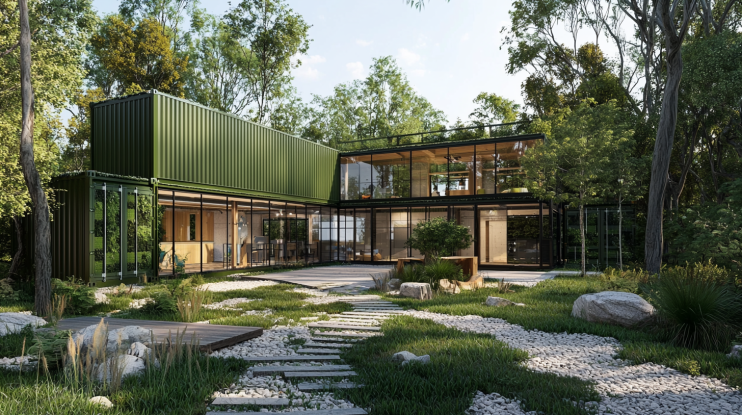
Serene 40-feet double-storey L-shaped container office in forest green, perfect for retreats.
Future Trends in Construction
The construction industry is rapidly evolving, with both Portacabins and traditional buildings seeing significant advancements. For Portacabins, future trends are leaning towards greater sustainability, enhanced customization, and the integration of smart technology. The modular nature of Portacabins makes them ideal for incorporating green building practices, such as using recycled materials and energy-efficient systems. Additionally, the ability to quickly adapt to new technologies means that Portacabins can be equipped with smart features like automated climate control, security systems, and advanced connectivity options, making them more attractive for modern applications.
Traditional buildings, while rooted in long-standing construction practices, are also experiencing innovation. The use of sustainable materials, such as cross-laminated timber and energy-efficient building techniques, is becoming more common. Moreover, advancements in building information modeling (BIM) and 3D printing are making traditional construction more precise, efficient, and environmentally friendly. These technologies allow for better planning, reduced waste, and faster construction times, bridging the gap between traditional and modular methods.
Looking ahead, the future of construction will likely involve a blend of these approaches. As the demand for sustainable, flexible, and smart buildings grows, both Portacabins and traditional structures will continue to evolve. Hybrid models that combine the best aspects of modular and traditional construction could become the norm, offering the durability of traditional buildings with the flexibility and efficiency of Portacabins. This trend will provide consumers with more choices and better solutions to meet the diverse needs of modern living and working environments.
Conclusion: Making the Right Choice
Deciding between a Portacabin and a traditional building depends on a variety of factors, including your specific needs, budget, and long-term goals. Portacabins offer flexibility, speed, and cost-effectiveness, making them ideal for temporary or semi-permanent applications. They are especially suited for projects that require quick deployment, scalability, and mobility. On the other hand, traditional buildings provide durability, aesthetic appeal, and long-term investment potential, making them the preferred choice for permanent installations that require high levels of customization and resilience.
Both Portacabins and traditional buildings have their own sets of advantages and challenges. For projects where adaptability, lower costs, and quicker completion times are priorities, Portacabins present a compelling option. However, for those seeking a permanent, aesthetically pleasing structure that can stand the test of time, traditional buildings may be the better choice. Ultimately, the decision should be based on a careful evaluation of your project’s requirements, future growth potential, and the resources available to you.
By understanding the differences between these two construction methods, you can make an informed decision that aligns with your specific needs and expectations. Whether you choose a Portacabin for its versatility or a traditional building for its permanence, both options offer valuable solutions for different types of projects. The key is to assess your goals, budget, and timeline to determine which approach will provide the best outcomes for your particular situation.
If you’re still unsure, feel free to contact SAMAN Portable for expert advice tailored to your specific needs.
FAQs About Portacabin
What isa Portacabin?
A Portacabin is a prefabricated, portable structure designed for easy transportation and quick assembly. These cabins are typically constructed using materials like steel, aluminum, and timber, making them durable yet lightweight. They are widely used for temporary or semi-permanent purposes such as offices, storage units, accommodation, and classrooms. Their versatility and ease of installation make them a popular choice for various industries and emergency situations.
Can Portacabins be customized?
Yes, Portacabins can be highly customized to meet specific needs. Whether you require additional rooms, advanced insulation, or specific utilities like electricity and plumbing, Portacabins can be tailored to suit your requirements. Customization options extend to both interior and exterior designs, allowing you to create a functional and aesthetically pleasing space. This flexibility is one of the key advantages of choosing a Portacabin for your project.
How durable are Portacabins?
Portacabins are designed to be durable and withstand various environmental conditions. Built with strong materials such as steel frames and insulated panels, they offer resilience against weather elements like rain, wind, and snow. With proper maintenance, a Portacabin can last for many years, making them a reliable option for both short-term and long-term use.
Are Portacabins cost-effective?
Portacabins are generally more cost-effective than traditional buildings. Their prefabricated nature reduces construction time and labor costs, making them an economical choice. Additionally, they offer flexibility in terms of renting or purchasing, further lowering the financial barrier for businesses and individuals needing a quick and affordable space solution.
 Container Cafe
Container Cafe
















































































